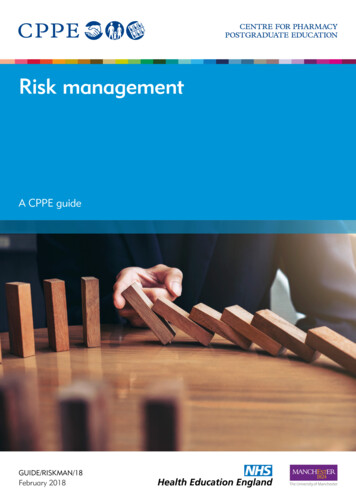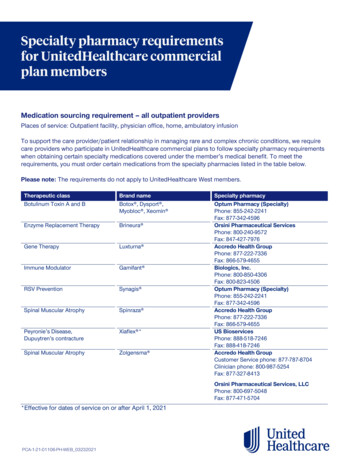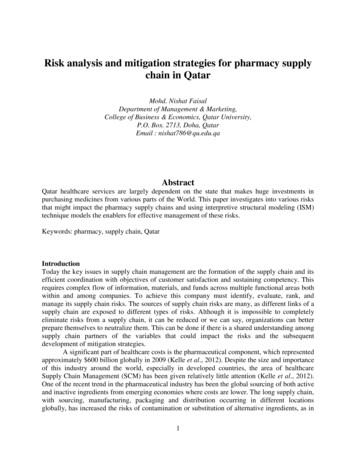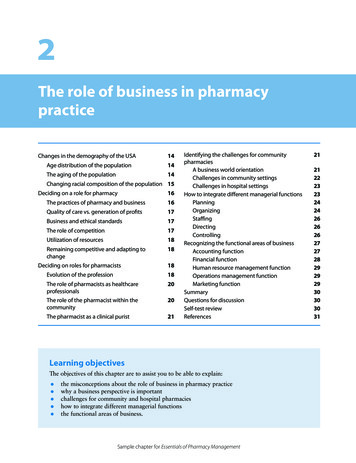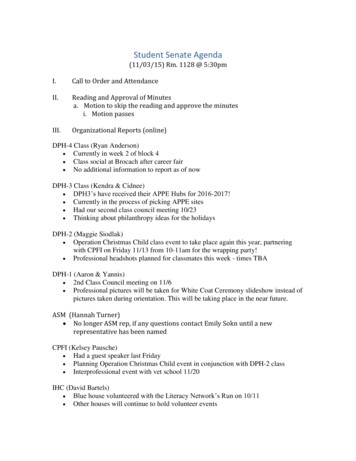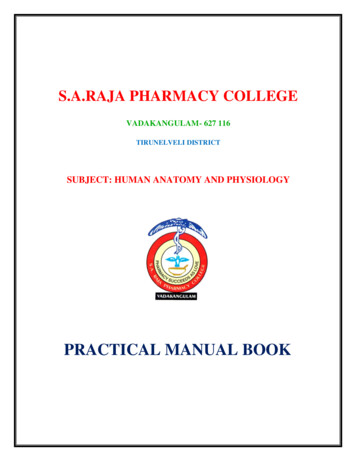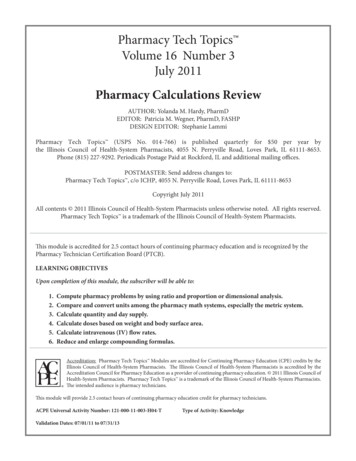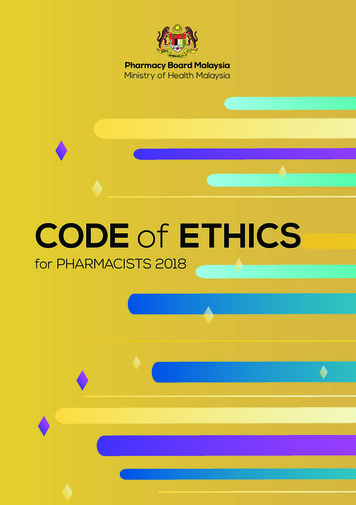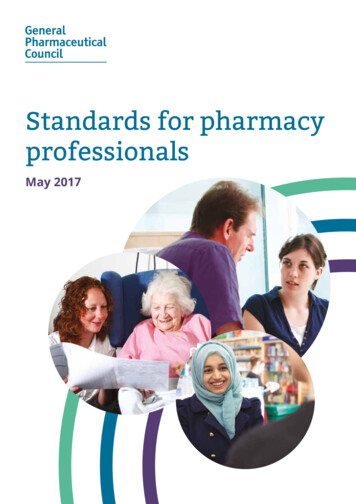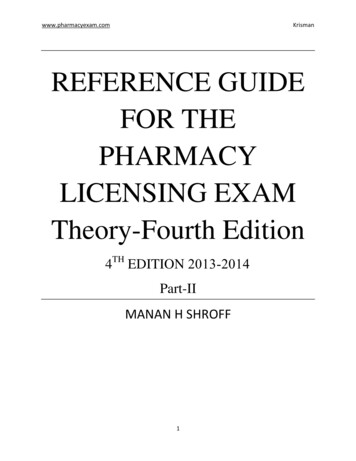
Transcription
www.pharmacyexam.comKrismanREFERENCE GUIDEFOR THEPHARMACYLICENSING EXAMTheory-Fourth Edition4TH EDITION 2013-2014Part-IIMANAN H SHROFF1
www.pharmacyexam.comKrismanThis book is not intended as a substitute for the advice of physicians. Students or readers must consulttheir physicians about any existing problems. Please do not use information provided in this book forany kind of self-treatment. Please do not administer any dose of mentioned drugs in this book withoutconsulting your physicians.This is only a review guide for the preparation of the North American Pharmacy Licensing Exam(NAPLEX ) and Canadian Qualifying Exam (CQE ). The author or editor is not responsible for any kind ofmisinterpreted, incorrect, or misleading information or any typographical errors in this book. Anydoubtful or questionable answers should be checked in other available reference sources.All rights reserved.No part of this book may be reproduced or transmitted in any form or by any means, electronicallyphotocopying, recording, or otherwise, without prior written permission of the publisher.RXEXAM is a registered trademark of Pharmacy Exam of Krishna Publications Inc. Any unauthorizeduse of this trademark will be considered a violation of law.NAPLEX and FPGEE are registered trademarks of the National Association of Boards of Pharmacy(NABP ). This review guide is in no way authorized by or sponsored by NABP .2
www.pharmacyexam.comKrismanPREFACEI am very happy to introduce the FOURTH edition of the Reference Guide for the Pharmacy LicensingExam-Theory. It is specifically written for students preparing for NAPLEX and QCE exams. It containsover 70 chapters and includes well organized therapeutic classifications at the beginning of eachchapter, with brand and generic names of medications.This review guide also covers over 3000 drugs; a sound knowledge of these drugs is an importantfactor for passing NAPLEX and QCE exams. I would also recommend the Reference Guide for thePharmacy Licensing Exam - Questions and Answers (over 1200 NAPLEX-type questions) and theReference Guide for Pharmaceutical Calculations (over 500 calculations).I hope my efforts will help you to pass your key exams. I wish you the very best of luck, and anyquestion or comment is always welcome.Good luck,Manan H. Shroff3
www.pharmacyexam.comKrismanTable of Contents38. BENIGN PROSTATIC HYPERPLASIA . 639. ERYTHROPOIESIS AND COLONY STIMULATING AGENTS . 840. HYPERURICEMIA AND GOUT. 1441. IMMUNOSUPPRESSANTS . 2042. ANTI-MIGRAINE. 3043. ANTI-EMETIC AGENTS . 3844. NON-STEROIDAL ANTI-INFLAMMATORY DRUGS . 4745. OPIOID ANALGESICS . 5946. OSTEOPOROSIS AND HYPO/HYPERCALCEMIA . 8047. ANTICOAGULANTS . 9648. THYROID . 10749. DIABETES . 11450. ULCERATIVE COLITIS . 13651. IRRITABLE BOWEL SYNDROME . 14052. ENURESIS/INCONTINENCE MANAGEMENT . 14553. DEMENTIA . 15254. MULTIPLE SCLEROSIS . 15655. MUSCLE RELAXANTS . 16456. CYSTIC FIBROSIS . 16957. ANTI-GLAUCOMA . 17258. ANTI-INFECTIVE OPHTHALAMIC AGENTS . 18159. SMOKING CESSATION AGENTS . 18460. EXPECTORANTS, ANTITUSSIVES, LAXATIVES, SCABICIDES & PEDICULICIDES . 18661. ACID-BASE DISORDER. 19162. ORAL CONTRACEPTIVES AND IMPOTENCE AGENTS . 19363. PSORIASIS . 20164. VITAMINS AND THEIR SOURCES . 20965. TERATOGENIC DRUGS . 21066. TOTAL PARENTERAL NUTRITION (TPN) . 2144
www.pharmacyexam.comKrisman67. RENAL FAILURE . 21668. INTERPRETATION OF CLINICAL LABORATORY TESTS . 22269. HERBAL DRUGS . 22570. NEW DRUG APPROVAL . 22871. CLINICAL DRUG LITERATURE . 23072. PHARMACOKINETICS . 23273. DRUGS AND THEIR ANTIDOTES . 2365
www.pharmacyexam.comKrisman38. BENIGN PROSTATIC HYPERPLASIAA). 5-Alpha-Reductase InhibitorsFinasterideDutasteride ProscarAvodartB). Specific Alpha-1 Blockers: (Please Refer Chapter 10 on page 64 of Part 1)PrazosinTerazosinDoxazosinAlfuzosinSilodosin MinipressHytrinCardura, Cardura XlUroxatralRapafloC). Specific Alpha-1 Blockers in a Prostate Gland: (Please Refer Chapter 10 on page 64 of Part 1)Tamsulosin Flomax JalynD). Combination Agents:Tamsulosin DutasterideDefinition: Benign Prostatic Hyperplasia is defined as an enlargement of the prostate gland which is oftenassociated with urination and bladder problems.A). 5-Alpha-Reductase InhibitorsFinasteride(Tablet)DoseSpecial Notes1. B.P.H.5 mg once a daywith or withoutfood.1). Finasteride (Proscar) is a specific inhibitor of steroid Type II 5αreductase; an intracellular enzyme that converts the androgentestosterone into 5α-dihydrotestosterone (DHT). The developmentand enlargement of the prostate gland is dependent on this potentandrogen, 5α-dihydrotestosterone (DHT).2. Androgeneticalopecia1 mg orally oncedaily with orwithout food.2). It is indicated for the treatment of symptomatic benign prostatichyperplasia (BPH) in men with an enlarged prostate to:i). Improve symptomsii). Reduce the risk of acute urinary retention (AUR)iii). Reduce the risk of the need for surgery including transurethralresection of the prostate (TURP) and prostatectomy.3). In combination with the alpha-blocker Doxazosin, It is indicated toreduce the risk of symptomatic progression of BPH.6
Special Notes4). Finasteride, under the brand name of Propecia, is indicated for thetreatment of male pattern hair loss (androgenetic alopecia) in MENONLY. It must NOT be used in children or women.5). Women should NOT handle crushed or broken Finasteride (Proscar)tablets when they are pregnant or may potentially be pregnantbecause of the possibility of absorption of Finasteride (Proscar) andthe subsequent potential risk to a male fetus. Finasteride (Proscar)tablets are coated and will prevent contact with the active ingredientduring normal handling, provided that the tablets have not beenbroken or crushed.6). Finasteride (Proscar) is classified under pregnancy category X.Dutasteride(Capsule)1). B.P.H.a). Avodart0.5 mg taken oncedaily with orwithout food.b). Jalyn0.5 mg Dutasteride,0.4 mg Tamsulosinonce daily with orwithout food.1). Dutasteride (Avodart) is a synthetic 4-azasteroid compound that isa selective inhibitor of both the type 1 and type 2 isoforms of steroid 5alpha-reductase, an intracellular enzyme that converts testosterone toDHT.2). Dutasteride (Avodart) is indicated for the treatment ofsymptomatic benign prostatic hyperplasia (BPH) in men with anenlarged prostate to:i). improve symptoms,ii). reduce the risk of acute urinary retention (AUR), andiii). reduce the risk of the need for BPH-related surgery.3). In combination with the alpha adrenergic antagonist, Tamsulosin, it(Jalyn) is indicated for the treatment of symptomatic BPH in men withan enlarged prostate.4). The capsules of Dutasteride (Avodart) should be swallowed wholeand not chewed or opened, as contact with the capsule contents mayresult in irritation of the oropharyngeal mucosa.5). Dutasteride (Avodart) capsules should NOT be handled by a womanwho is pregnant or who could become pregnant. Dutasteride(Avodart) is absorbed through the skin and could result in unintendedfetal exposure. If a woman who is pregnant or who could becomepregnant comes in contact with leaking dutasteride capsules, thecontact area should be washed immediately with soap and water. It isclassified under pregnancy category X.6). Impotence, decreased libido, breast disorders (including breastenlargement and tenderness), dizziness and ejaculation disorders aremost commonly reported side effects of Dutasteride (Avodart).7
www.pharmacyexam.comKrisman39. ERYTHROPOIESIS AND COLONY STIMULATING AGENTSA). Erythropoiesis-Stimulating Agents (ESAs)Epoetin alfaDarbepoetin alfaEpoetin beta methoxypropylene glycol Epogen, ProcritAranespMirceraB). Colony Stimulating Factors (CSF)FilgrastimPegfilgrastimSargramostimEpoetin alfa(Injection) NeupogenNeulastaLeukineDoseSpecial Notes1. Anemia due toChronic KidneyDisease:50 to 100 Units/kg3 times weekly IVor SC.1). Erythropoietin is a glycoprotein which stimulates red blood cellproduction. It is produced in the kidney and stimulates the divisionand differentiation of committed erythroid progenitors in the bonemarrow. Epoetin alfa (Epogen, Procrit), a 165 amino acid glycoproteinmanufactured by recombinant DNA technology, has the samebiological effects as endogenous erythropoietin.2. Zidovudineinduced anemia:100 Units/kg 3times weekly IV orSC.2). Epoetin alfa (Epogen, Procrit) is indicated for the anemia due to:3. Chemotherapyinduced anemia:150 Units/kgsubcutaneously 3times per weekuntil completionof a chemotherapycourse.4). Surgery Patients:300 Units/kg perday SC for 10 daysbefore surgery; onthe day of surgeryand 4 days aftersurgery.a). Chronic Kidney Disease (CKD)b). Zidovudine in HIV-infected Patientsc). Chemotherapy in Patients With Cancerd). To reduce the need for allogeneic blood transfusions in anemicpatients who are at high risk for perioperative blood loss from elective,noncardiac, nonvascular surgery.3). In clinical studies, patients experienced greater risks for death,serious cardiovascular events, and stroke when administerederythropoiesis-stimulating agents (ESAs) to target hemoglobin levels of13 g/dL and above. Therefore, it is advisable to individualize dosing toachieve and maintain hemoglobin levels within the range of 10 to 12g/dL or precisely 11 g/dL.4). An increased incidence of deep vein thrombosis, seriouscardiovascular events and strokes (especially in chronic renal failurepatients), pure red cell aplasia (PRCA), severe anemia, hypertensionand seizure are reported side effects of Epoetin alfa (Epogen, Procrit).8
www.pharmacyexam.comDoseEpoetin alfa(Injection)DarbepoetinAlfa(Injection)Special Notes5). ESAs shortened overall survival and/or increased the risk of tumorprogression or recurrence in clinical studies of patients with breast,non-small cell lung, head and neck, lymphoid, and cervical cancers.Because of these risks, prescribers and hospitals must enroll in andcomply with the ESA APPRISE Oncology Program to prescribe and/ordispense Epogen or Procrit to pati
(NAPLEX ) and Canadian . This review guide is in no way authorized by or sponsored by NABP . www.pharmacyexam.com Krisman 3 PREFACE I am very happy to introduce the FOURTH edition of the Reference Guide for the Pharmacy Licensing Exam-Theory. It is specifically written for students preparing for NAPLEX and QCE exams. It contains over 70 chapters and includes well organized therapeutic .

